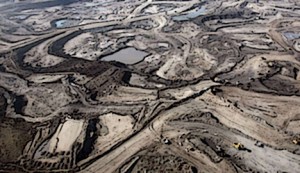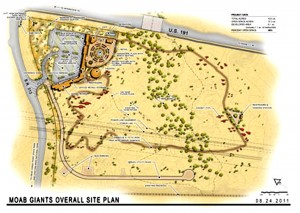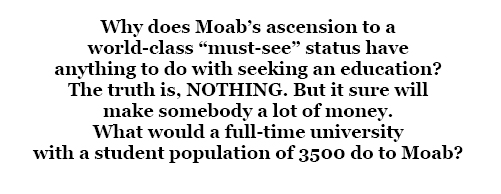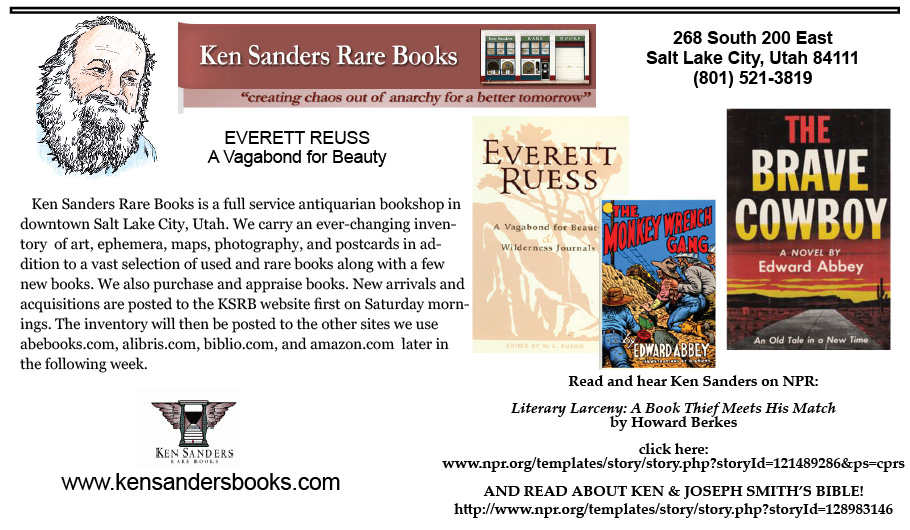In 1940, the Roosevelt administration hired out-of-work writers and photographers from coast to coast to create “travel guides” for each of the 48 states. The Federal Writers’ Project sent documentarians to the far corners of America. One of the most remote and unknown parts of the United States at the time was a little hamlet called Moab, Utah. Here is the way the writer described Moab, almost 75 years ago…
MOAB 31.9 m. (4,042 alt., 883 pop.), seat of Grand County, is the commercial center of an extensive sheep and cattle country, and since 1930 has achieved importance as a point of departure for scenic attractions in southeastern Utah. Though isolated it has a small business district, selling everything from hay and gasoline to malted milk and liquor—the only “legal” liquor in the county. Squat red adobe houses stand neighbor to more pretentious firebrick houses. In the evening neon lights illuminate the business district, but after midnight, except on Saturdays, the town does a complete “blackout.”….Moab has green trees, green lawns, green fields, but even this greenness comes from red soil. The town is on the Colorado River, which has an average annual flow of more than six million acre-feet, but gets its water from Mill Creek and Pack Creek, small streams flowing out of the La Sal Mountains.
The government re-printed the guides in 1950 with few if any revisions. But the country was about to change dramatically…to see itself turned upside down. The post-war boom would change the world, including unknown little Moab—soon it would become “the Uranium Capital of the World.”
In 1952 Charlie Steen discovered uranium in the canyon country of southeast Utah, in a place the experts said it didn’t exist. He became rich and thousands of fortune hunters descended upon Moab. The town was transformed in a matter of months. It’s never really been the same since.
Flash ahead to 2012. After a few booms and busts, Moab, in the beginning of the second decade of the 21st Century, is a New West town, caught once again in an identity crisis with itself. New Moab adamantly opposes the development of its potential energy resources. The extractive industries are anethema to environmentalists who hope to preserve what remains of the scenic beauty of the canyon country. Entrepreneurs pursuing an “amenities economy,” built around Moab’s nearby scenic attractions, also oppose energy exploitation. Proposals to pursue and exploit tar sands in the Book Cliffs north of Moab and plans to build a nuclear power plant near Green River, Utah, just 50 miles northwest, have met stiff and bitter opposition from many of Moab’s citizens.
New West town, caught once again in an identity crisis with itself. New Moab adamantly opposes the development of its potential energy resources. The extractive industries are anethema to environmentalists who hope to preserve what remains of the scenic beauty of the canyon country. Entrepreneurs pursuing an “amenities economy,” built around Moab’s nearby scenic attractions, also oppose energy exploitation. Proposals to pursue and exploit tar sands in the Book Cliffs north of Moab and plans to build a nuclear power plant near Green River, Utah, just 50 miles northwest, have met stiff and bitter opposition from many of Moab’s citizens.
On the other hand, other kinds of development that could also inalterably change the Moab/Grand County area have been embraced or, at accepted without resistance, by the more ‘progressive’ components of Moab.
Recently, Utah State University announced plans to pursue a full-time campus in Moab that will allow its 20 acre campus to grow steadily, to 600 and ultimately to as many as 3500 students in 30 years. There seems to be little opposition to this kind of dramatic increase in Moab’s population.
And just last week, the Moab Times-Independent ran a story about another proposed theme park to capitalize on Moab’s tourist economy. Called “Moab Giants,” the new project calls for the construction of “an open-air dinosaur museum and park north of Moab.” According to the story, “The main buildings at the facility will be used for an indoor museum, retail sales and concessions, including a 76-seat café area, exhibit storage, and offices for visiting scientists and park operations. There will also be a 50-seat theater where patrons can learn about the history of the land in the area.
…Outdoor exhibits will incorporate life-sized, detailed dinosaur models created by Dinoproduct, a company well known for making the best full-scale dinosaur models using a marriage of business and science.”
 Despite the fact that the new theme park will sit at the junction of US 191 and State Highway 313, the entrance to Canyonlands National Park and Deadhorse Point State Park, the plan barely raised an eyebrow. Again, according to the T-I, “Only a handful of local residents attended Tuesday night’s public hearing to learn more about the proposed dinosaur park.”
Despite the fact that the new theme park will sit at the junction of US 191 and State Highway 313, the entrance to Canyonlands National Park and Deadhorse Point State Park, the plan barely raised an eyebrow. Again, according to the T-I, “Only a handful of local residents attended Tuesday night’s public hearing to learn more about the proposed dinosaur park.”
Clearly, to most Moabites and especially to its environmental community, neither of these two projects seems as destructive or damaging as the tar sands and nuke plant. It’s not even a close call.
But here’s what I don’t get. For those progressive liberal environmentalists who envision a better future for Moab, there is a word I hear more than any other. It’s almost a rallying point:
The word is ‘sustainability.’
I see the word bandied about constantly and enthusiastically and with great confidence. Several environmental organizations embrace the idea of a sustainable future for Moab. One group wants to “build a sustainable community and teach others how to do it.” It states, “We build energy-efficient housing, provide education on sustainability, and improve the housing conditions of the workforce through an affordable program.”
Another non-profit “is dedicated to facilitating an open-minded, non-partisan discussion about sustainability in Moab and Grand County Utah, and across the larger southwest region.”
The City of Moab gets in the act as well with its “Green Power in Moab” program and claims the community is “a leader in sustainable energy.”
The Chamber of Commerce points out that their, “primary purpose…is to ensure economic success and sustainability for your business and improved quality of life for our community.”
Moab even had its own “Sustainablity Festival.”
But how does Moab become the sustainable community that so many of its residents trumpet and how do any of these projects lend themselves to that goal?

For many, the idea that tar sands development or the construction of a nuclear power facility could contribute to a community’s sustainablity is not a question for debate. Recently when a group opposing tar sands in Utah announced plans for a public forum on the topic, Moab’s economic development coordinator, Ken Davey, asked via facebook if they planned to “have any speakers who support the tar sands development?” His idea was, a forum should offer all points of view.
In effect, the answer was ‘no.’ Most of those involved in the forum had not given the idea of a balanced representation much thought. They wrote, “The only folks we could find were from the company, and they are well-known to give misinformation. Which could be so confusing! So perhaps once the public is more informed, we can invite them over and grill them :)”
Davey objected, writing, “…if you are not interested in having a panel discussion, maybe you should change the name of the event to ‘A Rally Against Tar Sands.’”
The ensuing discussion resolved nothing. But if their goal is to create a sustainable future for southeast Utah, in the true sense of the word, it’s not hard to understand the omission. The outspoken environmentalist/author Derrick Jensen told Moab’s KZMU last autumn, “You have to ask: ‘What will the land allow?’ That’s the question…end of conversation.”
I doubt a nuke plant works well into that scenario.
But do these other projects fare better for a sustainable Moab?
The giant dinosaur theme park is probably another of those wacko ideas that finds their way to Moab, bounces along for a few years and then fades away. Or maybe not. Maybe it will take its cue from Moab’s trams and waterpark and be built and either languish for years in purgtory or be built and go broke. Still it’s striking how few waves it made when it was announced the project was “moving closer to reality.”. Not even little ripples. Perhaps it’s what most Moabites think they deserve these days. Who knows.
But the planned university campus is another kettle of fish.

Moab/Grand County currently supports a population of about 10,000 people. On any given day during tourist season (which is fast becoming most of the year), another few thousand, on a good day as many as 10,000, double the population of those who call Moab home. While the city touts its “Green Energy” program, the fact is, based on data from Rocky Mountain Power, Moab’s energy consumption continues to accelerate. While the recession has slowed building everywhere, until the last couple of years, residential and commercial construction grew at a pace far above the Utah average.
In short, there is nothing remotely ‘sustainable’ about Moab in 2012.
Utah State University is currently boosting the future of its Moab campus online. It has this to say about the future:
There is a bumper sticker seen on numerous cars that says, London, Paris, Tokyo, Moab? Moab is a destination location, locally, nationally, and internationally, as a must see, and should be on your bucket list. I am optimistic that higher education at Utah State University Moab, will draw a similar response in the not too distant future. USU Moab is becoming a world class education center in one of the most beautiful and diverse outdoor recreation locations in the world.
Why does Moab’s ascension to a world-class “must-see” status have anything to do with seeking an education? The truth is, NOTHING. But it sure will make somebody a lot of money.
What would a full-time university with a student population of 3500 do to Moab? If Moab were to find itself with 3500 additional part-time residents, it’s safe to assume that additional teachers and staff will be required as well. As the university gains recognition, more businesses will come to Moab to take economic advantage of this latest Moab Boom.
Factor in the number of others that will choose to move to Moab for all those other reasons (The Beautiful Canyons! The Magnificent Mountains! The Fabulous Colorado River!) and what do YOU think Moab will look like in 30 years?
It’s a ticking nightmare, but who has the cajones to say they’re against it?
If ANYBODY in the Moab/Grand County community who supports the concept of “sustainablity” thinks this is a good idea, they’re either lying or delusional or dangerously out of touch with Reality. I’d like to see the leaders of Moab’s sustainable movement speak out against this project. It doesn’t mean they’re against education. Hardly. Does anybody really think that Moab—the Spring Break Party Capital of the Rocky Mountain west—is well-placed to be a renowned institution of learning? It means that to be fair, they have to look evenly at ALL kinds of proposals for growth and development. And the truth is, Moab U doesn’t pass the test.
 Finally a thought on those tar sands and the nuke plant. They are a nasty business, no doubt about it. I hope I never live to see either of them become operational in Utah. But as long as we keep consuming, the energy companies will keep producing, from wherever they can find it. There is a particular irony in a community that depends so heavily on an “amenities”economy—one that REQUIRES the consumption of massive amounts of energy, just to get all those tourists into the area—and simultaneously loathes any and all forms of energy extraction and production.
Finally a thought on those tar sands and the nuke plant. They are a nasty business, no doubt about it. I hope I never live to see either of them become operational in Utah. But as long as we keep consuming, the energy companies will keep producing, from wherever they can find it. There is a particular irony in a community that depends so heavily on an “amenities”economy—one that REQUIRES the consumption of massive amounts of energy, just to get all those tourists into the area—and simultaneously loathes any and all forms of energy extraction and production.
It is, after all, the production of energy that allows those millions of tourists to travel hundreds or thousands of miles to see the canyon country and create an economy, of sorts, for so many who live there.
Could there ever, ever be anything less sustainable than a tourist economy? The last time Moab was truly sustainable was back in 1951, before Charlie Steen and uranium and before New Moab and before anyone had even heard the term. For Moab’s young idealists, it’s something they need to consider–what kinds of sacrifices are they willing to make to create a community that sustains itself. A real challenge for the future.
To read Jim’s other “Take it or Leave it” articles from this issue, follow these links:
The 99% (We Don\’t Like Each Other Very Much…)
George Clooney, President Obama, and the Loyal Voice of Dissent
Overpopulation…the Windex/Easy Off Solution
Don’t forget the Zephyr Ads! All links are hot!



It’s a ticking nightmare, but who has the cajones to say they’re against it?
…but Jim, who would use a stack of drawers to make a point???
e.g., i used to run the Canyonlands 13-mile in the spring, about ten times up until 1997 or so. it was getting, too … “big deal”. i prefer smaller friendlier events. this last event had almost FOUR-THOUSAND participants? THAT is why i quit coming to Moab. yeah, i know, when i (and my family) used to visit, as many as 6 times a year, it was a lot less hectic. we’d camp away from established campsites out in the BLM. i suppose this glut of the yearning masses running away from whatever is inevitable, though …
but you’ll be glad i’ll probably rarely be a part of it.
Hello Jim,
You wrote a “farewell” for Rocky Newell last year. I believe that I may be a distant relative of Rocky’s. Do you know if he was originally from the Boise, ID, area? (Emmett, ID) If so, please let me know. If you’re interested, I’ll share what I remember about Rocky if I hear back from you.
Thank You,
Dan Callan